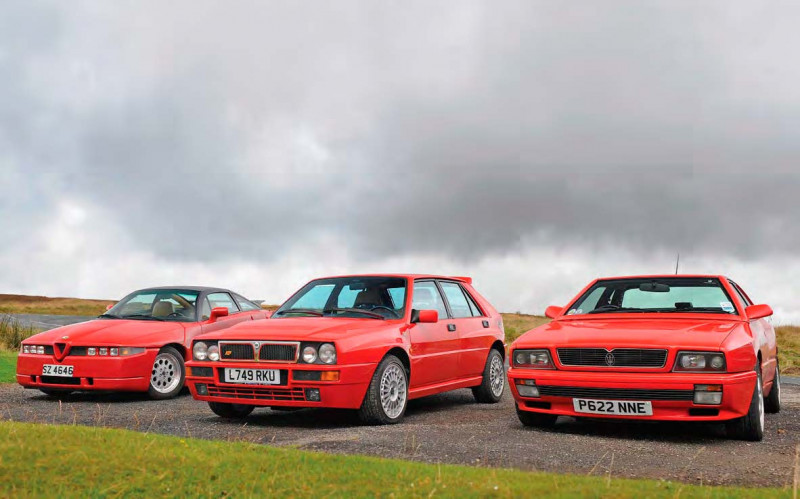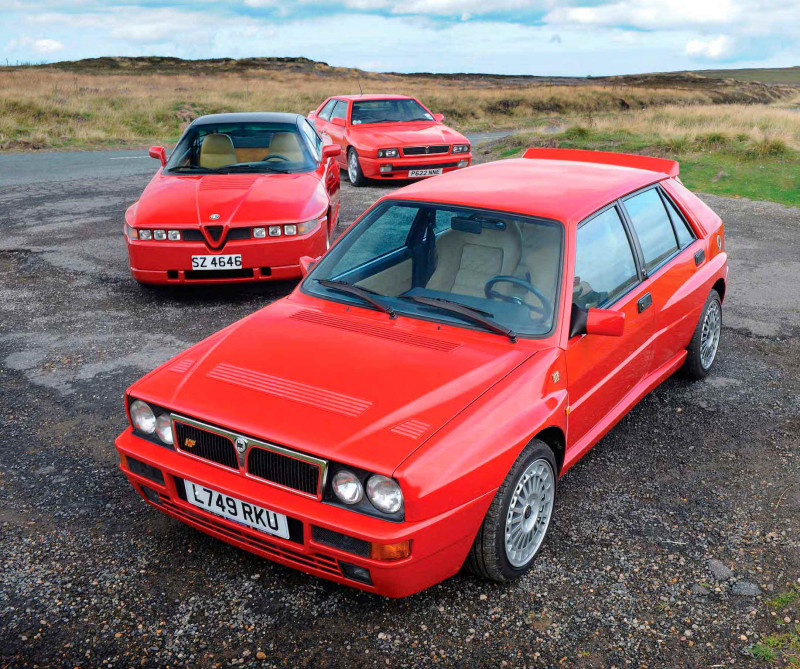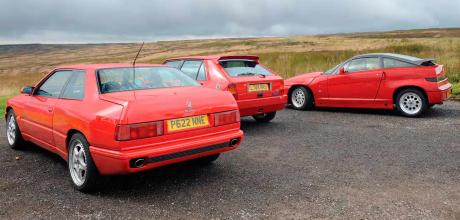Alfa Romeo SZ vs. Lancia Delta HF integrale or Maserati Ghibli Cup
The battle is on between three cars that exemplify the pinnacle of Italian competition breeding in the 1990s. Which one – Alfa Romeo SZ, Lancia Delta HF integrale or Maserati Ghibli Cup – wins our hearts? Words: Nathan Chadwick. Pictures: Michael Ward.
ALFA SZ V LANCIA DELTA V MASERATI GHIBLI 1990s masters of grip go head to head
MASTERS OF GRIP: ALFA SZ V LANCIA DELTA V GHIBLI CUP
It feels like a stage on the RAC Rally. The sky is thick with fog and I can smell the rain lingering in the air and feel its icy pinpricks slamming into my face, propelled by a typically robust North Yorkshire breeze. In some ways, it’s far from the perfect weather for testing three ultimate performance Italian road warriors of the 1990s. Yet the rally stage conditions do seem fitting in one regard: each of the red triplet in front of me has its origins in motorsport.

First to hone into view is the Alfa Romeo SZ. This was a concept car made real, but it was absolutely no show pony. The Alfa 75-based chassis was honed by racers such as Miki Biasion, Riccardo Patrese and Nicola Larini, before receiving its evocative Busso V6 heart and plastic bodywork. The Lancia Delta HF integrale is more than a car, and more than just the roadgoing version of a highly successful rally car; it is an everyman’s hero. Finally, we have the Maserati Ghibli Cup, the ultimate evolution of the Biturbo line in V6, and the most focused Maserati road car to go on sale in the UK for a generation.
All these cars can be bought from around the £40,000 mark, although you can pay an awful lot more for mint, low-mileage examples, and many multiples of that figure in the case of special edition integrales. All three cars are unquestionably winners, but which one cuts through its own mythology to deliver peak roadgoing adrenaline right now? Let’s find out.

ALFA ROMEO SZ
Of our triplet of cars here, this is the one that divides opinion the most. Call it Il Mostro, call it ES30, call it SZ – Robert Opron and Antonio Castellana’s deceptively square cut vision of otherness still looks otherworldly, a Blade Runner spinner with number plates.
Frankly, you either love it or hate it; it’s not a car for half measures. There were certainly none of those taken during this car’s truncated development. It took just 19 months from initial pitch as a halo model, reigniting the passion for Alfa Romeo (newly acquired by Fiat), to being churned out (but not designed) by Zagato’s Terrazzano di Rho factory. The car’s chassis would be thoroughly tested by the likes of Miki Biasion, Riccardo Patrese, Alessandro Nannini and Nicola Larini, among others. The result was a car that out-handled almost anything else, ever, according to Performance Car magazine – even the now more venerated and more expensive BMW M3 Sport Evolution.
The chassis owes its origins to the Alfa 75, but not just any version. It’s pretty much the same specification as the IMSA racing cars campaigned on the Giro d’Italia by Messrs Biasion, Patrese et al, devised by Fiat Group motorsport maestro Giorgio Pianta, and then transferred to a road car. The result is a car that was claimed at the time to pull a record-breaking 1.5g of force in corners. That’s impressive for 2020, let alone the late 1980s – Group A homologation 4x4s only really started to get close to that in the mid-1990s.
As such, hustling the SZ is a bit like being in a tarmac rally car, with the road unspooling in front of you in a seemingly effortless manner, the likes of which you’d only seen on grainy footage of the Manx rally in the 1990s. The suspension can be hard – it transmits hard shocks with vigour – but on cambers and minor corrugations, this tarmac rally-spec suspension manages to be supple enough to get the power down, yet not list from apex to apex with body roll. The steering is well-weighted, accurate, and so engaging – in the dry, the SZ feels so planted that it makes four-driven wheels seem almost superfluous.
However, with only 210hp on tap, don’t expect supercar levels of acceleration. Even back in the day, the SZ was left behind by many other cars at its price point. Alfa had a 24-valve version of its venerable Giuseppe Busso-designed V6 in the pipeline, but it sadly didn’t make it in time for the SZ, which made do with 12 valves. This unit hauls the SZ to 60mph in a brisk seven seconds, which is about on par with a Ford Fiesta ST these days.
Uncle Henry’s gilded shopping cart will never get the heart pumping like the SZ when it’s encouraged to sing, though. The SZ is hardly light – it may be formed from composite materials, with a pioneering carbonfibre rear wing, but it’s still fairly porky for the age. Anyone who’s opened the bonnet will understand the need for muscle, as lifting the clamshell is not for the weak of bicep. Still, all the more reason to rev those six cylinders out – and the pay-off is pure sonic theatre. Soon it matters little that the Ford Fiesta ST will outdrag you – the SZ is all about feel and engagement, and the SZ serves that up with aplomb.
And as for the looks? I love them. It’s a stubby two-fingered salute to staid, traditional views of what constitutes ‘beautiful design’. It’s a generational thing, too. Imagine gatecrashing the Last Night of the Proms with a Sex Pistols LP, or gatecrashing a high society opera with some particularly gnarly drum and bass. There’s something inherently naughty, antiestablishment and vigorously subversive about the SZ.
Add in its on-road abilities, plus the emotive sound of its six pots warming up for the next national speed limit aria, and the other cars here have a very tough act to follow.
Super-grippy chassis and adjustable handling are SZ’s party pieces. Ride is hard, looks are divisive
“ Driving Il Mostro feels like gatecrashing the Last Night of the Proms with a Sex Pistols LP ”
LANCIA DELTA HF INTEGRALE EVO II
Of all the cars here, the Deltagrale is the most iconic. Aside from its World Rally Championship exploits; aside from its video game hero status (thanks to Sega Rally and almost every racing game since); it is a legendary roadgoing classic. Even in the end-of-the-line 1993 Evo II specification we have here, its power output of 215hp is, like the SZ, outgunned by modern metal, but the steady stream of gawping onlookers attests to the fact that this matters little.
Seasoned Deltagrale aficionados will point out that most of the rally car’s winning was done with the non- Evo models, and that the 16v is the pick of the range. And the six-figure sums paid for limited edition Evo IIs at auction seem faintly absurd. But just look at it: a clenched fist of barely contained aggression that makes the other two cars here seem almost demure. The pumped-up arches, designed on the hoof with cardboard cut-outs just to make the bigger wheels fit; the engorged bonnet to accommodate the higher strut tops; the cheeky adjustable rear spoiler. It all screams competition from beginning to end. This is a car built entirely for dominating B-roads.
Which is handily what we have before us, still wearing the dampness of a passing rain shower. The other two cars here have tricky reputations in the wet, but the four-wheel drive Lancia merely shrugs its shoulders and gets stuck in. And get stuck in is precisely what you need to do, because driven slowly, the Evo II doesn’t quite have the same theatre as the SZ. The Lampredi twin-cam is an emotive unit in naturally aspirated form, all fizz and buzz, but the Evo II was tuned for less lag; the steering, so talkative on the 16v, is a little on the remote side. Could the Evo 2’s outward armour be flattering to deceive, in a similar way to its outrageous-looking but actually refined arch-rival, the Ford Escort RS Cosworth?
Not a bit of it; nail the throttle and the Lancia stings into immediate action, the four-wheel drive system hooking up immediate traction and forward momentum. As the pace rises, the steering comes alive, bristling with feedback on what’s going on at tread-block level. Pretty soon, apexes are your playground – point the car into the exit, nail the throttle and you’re hauled through like you’re a carp on the end of a fishing line.
It may be four-wheel drive, but you are still at the centre of the action. The full-time all-wheel drive has an epicyclic centre differential paired with a Ferguson viscous coupling, with a Torsen-style rear differential; the torque split of 47/53 front/rear gives a mildly rearward chassis feel, but mostly it feels neutral. That means that it just goes where you point it – trust in the technology, it works.
Lancia may have tuned out some of the lag via ECU tweaks, but this is still a peaky machine, delivering its torque thrust with a suitably excited whinny. It’s the kind of theatre that more modern cars are lacking. The new Toyota Yaris GR, for example, is touted as a Deltagrale for the 21st century, but in that car the theatre only begins when the laws of physics start to be questioned.
Once the Delta’s warmed up, at a less Daily Mailbaiting speed, it’s always talking to you, through the pedals, the steering wheel and the gearknob. Then there’s the instrument binnacle – hardly the easiest to decipher but the look of a vintage synthesiser about it is beguiling. It all adds to the theatre – nothing feels, drives or indeed smells like an integrale.
This is a raw Cabaret Voltaire B-side of a car, all growl and hiss as the Lampredi four-pot seeks out another corner. In relative terms you’re not going particularly fast, but because there’s remarkably little between you and the outside world, a world painted vividly through the enormous glasshouse, you feel immediately part of the action. Next stop, Kielder Forest.
Even on damp tarmac, the Delta never misses a beat. Iconic design is matched every inch by the experience.
MASERATI GHIBLI CUP
What if there were a car that offered the peaky, laughout- loud, all-or-nothing turbocharged power delivery and dry-weather traction of the Lancia, but with the sonorous six-cylinder harmony and steering precision of the SZ? Oh, and 50 per cent more power, all wrapped up in a Marcello Gandini-styled package?
The Maserati Ghibli Cup is that car. Born to celebrate a one-make racing series at the insistence of hardcore British Trident enthusiasts, the Cup represents the peak of Maserati’s V6 Biturbo line. The 2.0-litre version of the standard Ghibli II’s twin-boosted V6 was denied to British buyers; in standard form, that produced 306hp at 6250rpm and, perhaps more critically, 275lb ft of torque at a fairly peaky 4250rpm. Export markets like the UK received a 2.8-litre V6 with 281hp at 6000rpm and 305lb ft at a chunkily low 3500rpm. Although the 2.0-litre V6 was warmly received by British journalists at a test day at Goodwood, the British importer believed it wouldn’t be a success in the UK. The prevailing feeling was that the Ghibli II was more of a GT than a performance car.
However a group of ardent UK Maserati fans disagreed, and by 1997 Modena had something for them – the Cup. The output of 330hp at 6500rpm from its 2.0-litre twin-turbo V6, achieved with a freer-flowing exhaust and an ECU tweak, was the highest figure per litre of any engine in the world at the time (165.3hp per litre).
Behind the Speedline split-rim alloy wheels lurk Brembo brakes and lower, stiffer suspension allied to Koni adjustable dampers. It certainly looks the part: its wide hips, furrowed brow and raked stance give it the look of a thug in an Armani suit, its biceps only just covered by the exterior tailoring.
It goes like a thug, too. Not much really happens below 3000rpm, as the engine goes about its business with a gruff, almost V8-style grumble. Then the V6 starts to sing with a smooth, heart-warming zing. And then in come the turbos, their high-pitched whine indicating that the immediate future has become now, and that the next straight is much shorter than you thought it was. The lag isn’t bad, although judged by modern standards it certainly feels pronounced. However, the natural torque of the V6 means that the engine is far easier to keep on the boil than the Lancia’s.
The steering helps with this. Not only is the most heavily weighted steering of any Maserati I’ve experienced (both older and newer) but it’s also the most accurate and the most talkative through the thick Momo steering wheel. Just like the SZ, it keys into your synapses, to the point where your arms feel intimately connected to the front suspension, and your behind has an innate sense for the traction out back. It is possible to get very lairy in a Cup, but you have to provoke it to do so. At quick road speeds the rear limited-slip diff seemingly chomps into the road surface, giving you utter confidence that it will stick. That means you can press on harder, riding the natural V6 torque wave and letting the turbos boost just as you exit the apex.
The key here is the steering, which sharpens up dramatically depending on which damping mode you’re in. The hardest setting is too punishing for the roads I’m driving today, but flitting between settings 2 and 3 allows an excellent mixture of compliance and response. The great thing about the Ghibli Cup is that it can settle down and simply be a car. There’s Connolly leather, squishy seats and plenty of room (even if the pedal box is a bit of a squeeze); it works as a car you could use every day. Indeed, this one’s done 96,000 miles – who said Maseratis were unreliable?
The Ghibli Cup can be relied upon for serving up excitement. Some prefer the contemporary Shamal with its 326hp V8 engine, or even the base 2.8 with its easy torque and GT sensibilities. The Cup, however, is much sportier and much more aggressive – it demands more from the driver, but it more than rewards in recompense. Let’s just say that, each time I stepped out of it after a spirited run, I felt the need for a cigarette…
Limited-slip diff helps put power down. Adjustable suspension plays to broad range of driving styles.
“ The steering is the most heavily weighted of any Maserati I’ve experienced, and the most accurate and talkative through the thick Momo wheel ”
Ghibli Cup is easily the most powerful of our trio, while that Marcello Gandini styling oozes character
VERDICT
All three cars are winners but I’m going to stick my keys on the table: I love the Ghibli Cup, as it blends the best of the SZ and integrale. It’s as if they met half way between Turin and Milan for a romp in the bushes and came up with a renegade. This Maserati sits as an outlier to much of what the Trident marque did before or has done since. In terms of steering feel, it’s in a class of its own.
However, there are caveats – firstly, only 60 Ghibli Cups were made with the 2.0-litre engine, and even with my Trident apologist hat on, looking after one requires a level of commitment, both fiscal and emotional, that will truly challenge even the most ardent petrolhead.
So to be more objective, it’s down to the Delta and the SZ. The Delta may be an icon, but it only starts to feel special when you absolute hammer it. The SZ feels special from the second you open the garage and set your eyes upon it, to the moment you nestle into the surprisingly spacious biscuit-leather interior. And then there’s the Busso V6 engine note. Even if the accolades ended there, the SZ would just about have the edge on the Lancia, but the fact that, even without four-wheel drive, the Alfa feels just as alert, adept and planted in the dry, makes it the stand-out car here. That said, pick any of these cars and you’ll feel like you’re a winner. Now, how to find a garage that can fit all three?
Thanks to Mike Grey, Dave Kenton, John Connor, the Maserati Owners’ Club, the Alfa Romeo Owners’ Club, Alfa Aid (alfaid.co.uk) and Walker’s Garage (walkers-garage.co.uk)
| CAR: | ALFA ROMEO SZ | LANCIA DELTA INTEGRALE EVO II | MASERATI GHIBLI CUP |
| ENGINE: | 2959cc V6 SOHC 12v | 1995cc 4-cyl DOHC 16v turbo | 1996cc V6 DOHC 24v twin-turbo |
| POWER: | 210hp at 6200rpm | 215hp at 5750rpm | 330hp at 6750rpm |
| TORQUE: | 181lb ft at 4500rpm | 232lb ft at 2500rpm | 274lb ft at 4500rpm |
| TRANSMISSION: | 5-speed manual, RWD | 5-speed manual, 4WD | 6-speed manual, RWD |
| WEIGHT: | 1256kg | 1340kg | 1365kg |
| MAX SPEED: | 152mph | 137mph | 168mph |
| 0-62MPH: | 7.0sec | 5.8sec | 5.8sec |
| PRICE WHEN NEW: | £40,000 (1990) | £25,000 (1993) | £47,500 (1997) |
| VALUE TODAY: | £40,000-£80,000 | £40,000-£100,000 | £35,000-£80,000 |


